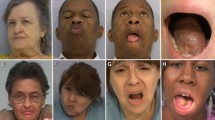Abstract
Vacuous chewing movements (VCMs) in three different rat strains developed at considerably different rates after 19 weeks of continual haloperidol treatment at an average daily dose of 1.5 mg/kg. Sprague Dawley (SD) rats displayed relatively high rates of VCMs with low variability, compared to Wistar (W) and Long Evan (LE) rats. Atropine decreased but did not abolish VCMs in two of the three strains (LE>SD). After haloperidol withdrawal, VCMs remitted gradually in all strains, but least rapidly in the SD rats. In a separate group of SD rats, VCMs were rated weekly from the start of haloperidol treatment and showed considerable interindividual variability. Even after 24 weeks of continuous haloperidol, 12 out of 32 treated rats showed no VCMs at all, while 13 out of 32 had intense movements, analogous to the clinical situation in which only some patients treated with neuroleptics develop tardive dyskinesia. These results indicate that there are individual and strain differences in the development of VCMs, and suggest that there may also be genetically determined differences in the development of tardive dyskinesia.
Similar content being viewed by others
References
Bianchetti G, Morselli FL (1978) A rapid and sensitive method for detection of haloperidol in human samples using nitrogenphosphorus selective detection. J Chromatogr 153:203–209
Casey DE, Toenniessen LM (1983) Neuroleptic treatment in tardive dyskinesia: can it be developed into a clinical strategy for long-term treatment? In: Bannet J, Belmaker RH (eds) New directions in tardive dyskinesia research. Karger, Basel, pp 65–79
Clow JM (1980) Changes in cerebral dopamine treatment, long-term effects of neuroleptics. Adv Biochem Psychopharmacol 24:335–340
Gardos G, Cole JO, Rapkin et al. (1984) Anticholinergic challenge and neuroleptic withdrawal. Arch Gen Psychiatry 41:1030–1035
Gunne LM, Growdon J, Glaeser B (1982) Oral dyskinesia in rats following brain lesions and neuroleptic drug administration. Psychopharmacology 77:134–139
Iversen SD, Howells RB, Hughes RF (1980) Behavioral consequences of long-term treatment with neuroleptic drugs. Adv Biochem Psychopharmacol 24:305–313
Jeste DV, Wyatt RJ (1979) In search of a treatment for tardive dyskinesia: review of the literature. Schizophr Bull 5:251–292
Kane JM, Woerner M, Lieberman J, (1985) Tardive dyskinesia: prevalence incidence, and risk factors In: Casey DE, Chase TN, Christensen AV, Gerlach J (eds) Dyskinesia research and treatment Springer Berlin Heidelberg New York, pp 72–78
Klawans HL, Rubovits R (1972) An experimental model of tardive dyskinesia. J Neural Transm 33:235–246
Lahti AC, Thaker GK, Nguyen JA, Moran M, Tamminga CA (1988) Reversibility of tardive dyskinesia following neuroleptic withdrawal. Neurosci Abstr 14:498
Magliozzi JR, Hollister L, Arnold KV, Earle GM (1981) Relationship of serum haloperidol levels to clinical response in schizophrenic patients. Am J Psychiatry 138:365–368
Mithani S, Atmadja S, Baimbridge KG, Fibinger HC (1987) Neuroleptic-induced oral dyskinesias: effects of progabide and lack of correlation with regional changes in glutamic acid decarboxylase and choline acetyltransferase activities. Psychopharmacology 93:94–100
Rupniak NMJ, Mann S, Hall MD, Fleminger S, Kilpatrick G, Jenner P, Marsden CD (1984) Differential effects of continuous administration for 1 year of haloperidol or sulpiride on striatal dopamine function in the rat. Psychopharmacology 4:503–511
Smith RC, Baumgartner R, Misra CH, Mauldin M, Shvartsburd A, Ho BT, DeJohn C (1984) Haloperidol. Arch Gen Psychiatry 41:1044–1049
Tamminga CA, Thaker GK, Chase TN (1985) GABA dysfunction in the pathophysiology of tardive dyskinesia. In: Casey DE, Chase TN, Christensen AV, Gerlach J (eds) Dyskinesia reserach and treatment. Springer, Berlin Heidelberg New York, pp 122–127
Tarsy D, Baldessarini RJ (1974) Behavioral supersensitivity to apomorphine following chronic treatment with drugs which interfere with the synaptic functions of catecholamines. Neuropharmacology 13:927–940
Thaker GK, Tamminga CA, Alphs LD, Lafferman J, Ferraro TN, Hare TA (1987) Brain gamma aminobutyric acid abnormality in tardive dyskinesia. Arch Gen Psychiatry 44:522–529
Waddington JL, Youssef HA (1988) The expression of schizophrenia affective disorder, and vulnerability to tardive dyskinesia in an unusual and extensive Irish pedigree. Br J Psychiatry (in press)
Waddington JL, Cross AJ, Gamble SJ, Bourne RC (1982) Spontaneous orofacial dyskinesia and dopaminergic function in rats after 6 months of neuroleptic treatment. Science 220:530–532
Author information
Authors and Affiliations
Rights and permissions
About this article
Cite this article
Tamminga, C.A., Dale, J.M., Goodman, L. et al. Neuroleptic-induced vacuous chewing movements as an animal model of tardive dyskinesia: a study in three rat strains. Psychopharmacology 102, 474–478 (1990). https://doi.org/10.1007/BF02247127
Received:
Revised:
Issue Date:
DOI: https://doi.org/10.1007/BF02247127




